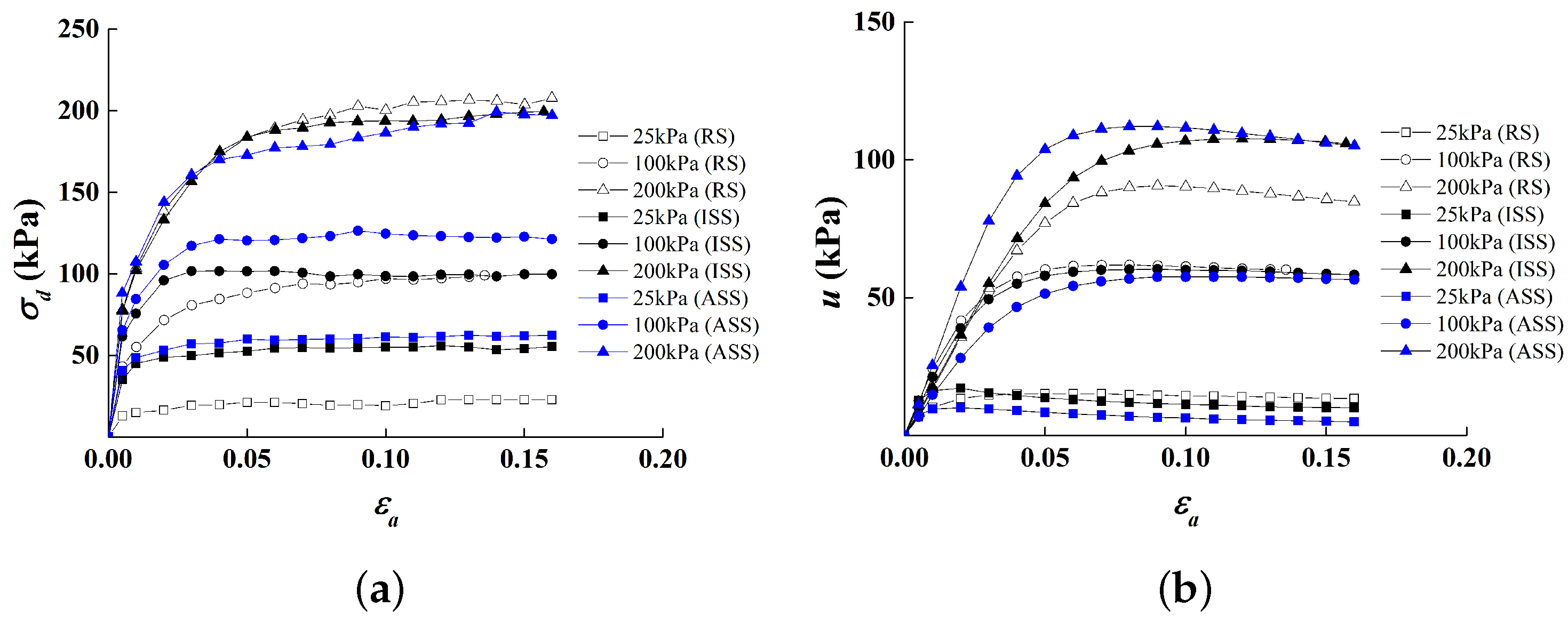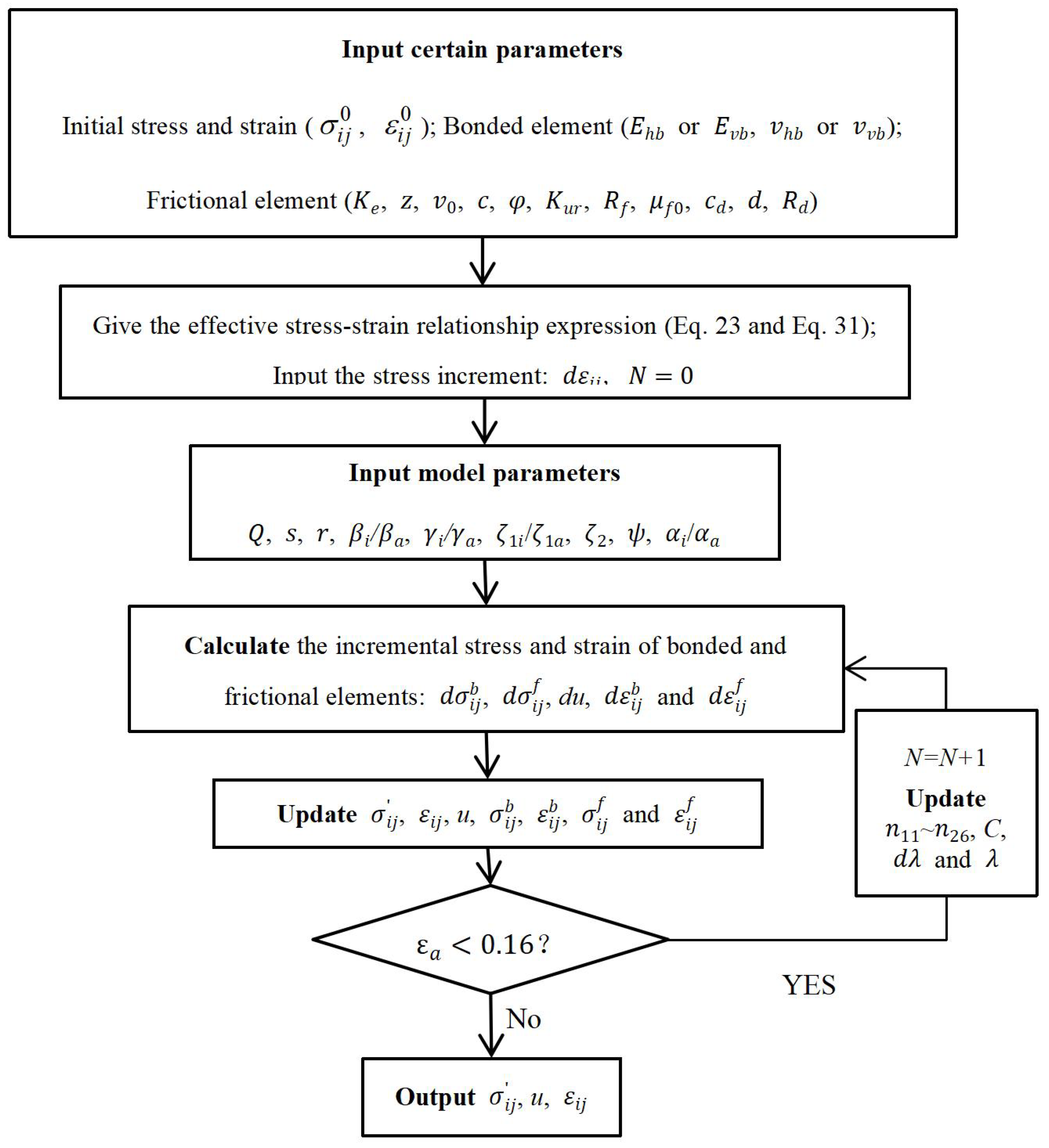Mechanical Properties and Constitutive Model for Artificially Structured Soils under Undrained Conditions
Abstract
:1. Introduction
2. Test Results of Structured Soils
2.1. Sample Preparation
2.2. Results and Analysis
3. Constitutive Model for Artificially Structured Soils
3.1. Formulation of Binary-Medium Constitutive Model
3.2. Constitutive Relationship of Bonded Elements
3.3. Constitutive Relationship of Frictional Elements
3.4. Structural Parameters of Breakage Ratio and Local Stress Coefficient Matrix
4. Determination of Model Parameters and Model Verification
4.1. Determination of Model Parameters for Bonded Elements
4.2. Determination of Model Parameters for Frictional Elements
4.3. Determination of Structural Parameters
4.4. Model Verification
5. Conclusions
Author Contributions
Funding
Data Availability Statement
Conflicts of Interest
References
- Burland, J.B. On the compressibility and shear strength of natural clays. Géotechnique 1990, 40, 329–378. [Google Scholar] [CrossRef]
- Lambe, T.W.; Whitman, R.V. Soil Mechanics; Wiley: New York, NY, USA, 1969. [Google Scholar]
- Mitchell, J.K. Soil Mechanics; Wiley: New York, NY, USA, 1976. [Google Scholar]
- Mitchell, J.K.; Houston, W.N. Causes of clay sensitivity. J. Soil Mech. Found. Div. 1969, 95, 845–871. [Google Scholar] [CrossRef]
- Liu, M.D.; Carter, J.P.; Liu, M.D.; Carter, J.P. Virgin compression of structured soils. Géotechnique 1999, 49, 43–57. [Google Scholar] [CrossRef]
- Low, H.E.; Phoon, K.K.; Tan, T.S.; Leroueil, S. Effect of soil microstructure on the compressibility of natural Singapore marine clay. Can. Geotech. J. 2008, 45, 161–176. [Google Scholar] [CrossRef]
- Hong, Z.; Han, J. Evaluation of Sample Quality of Sensitive Clay Using Intrinsic Compression Concept. J. Geotech. Geoenviron. 2007, 133, 83–90. [Google Scholar] [CrossRef]
- Hong, Z.S.; Zeng, L.L.; Cui, Y.J.; Cai, Y.Q.; Lin, C. Compression Behaviour of Natural and Reconstituted Clays. Géotechnique 2012, 62, 291–301. [Google Scholar] [CrossRef]
- Consoli, N.C.; Rotta, G.V.; Prietto, P.M.D. The influence of curing under stress on the triaxial response of cemented soils. Géotechnique 2000, 50, 99–105. [Google Scholar] [CrossRef]
- Rosa, F.D.; Consoli, N.C.; Baudet, B.A. An experimental investigation of the behaviour of artificially cemented soil cured under stress. Géotechnique 2008, 58, 675–679. [Google Scholar] [CrossRef]
- Wang, D.X.; Leena, K.T. On the normalized behavior of naturally and artificially structured clays. Eng. Geol. 2016, 214, 20–28. [Google Scholar] [CrossRef]
- Ling, D.S.; Li, J.; Wang, W.J.; Hu, C.B. Structure of artificial soils and its influence on strain localization. J. Zhejiang Univ. (Eng. Sci.) 2019, 53, 1689–1696. [Google Scholar] [CrossRef]
- Graham, J.; Houlsby, G.T. Anisotropic elasticity of a natural clay. Géotechnique 1983, 33, 165–180. [Google Scholar] [CrossRef]
- Calabresi, G.; Callisto, L. Mechanical behaviour of a natural soft clay. Géotechnique 1998, 48, 495–513. [Google Scholar] [CrossRef]
- Nishimura, S.; Minh, N.A.; Jardine, R.J. Shear strength anisotropy of natural London Clay. Géotechnique 2007, 57, 49–62. [Google Scholar] [CrossRef]
- Ng, C.W.W.; Akinniyi, D.B.; Zhou, C. Influence of structure on the compression and shear behaviour of a saturated lateritic clay. Acta Geotech. 2020, 15, 3433–3441. [Google Scholar] [CrossRef]
- Jin, P.; Chen, B.; Hu, Y.S. Loading rate on the mechanical behaviour of structured clays. Aust. J. Mech. Eng. 2019, 16, 16–22. [Google Scholar] [CrossRef]
- Kong, L.W.; Zang, M.; Guo, A.G.; Tuo, Y.F. Effect of stress path on strength properties of Zhanjiang strong structured clay. Rock Soil Mech. 2015, 36, 19–24. [Google Scholar] [CrossRef]
- Liu, E.; Wang, S.; Zhou, C.; Nie, Q. Mechanical Properties of Artificial Structured Soils Under a Conventional Drained Loading–Unloading–Reloading Stress Path. Int. J. Civ. Eng. 2018, 16, 383–393. [Google Scholar] [CrossRef]
- Zhu, N.; Liu, C.Y.; Zhao, X.H.; Wang, W.J. Micro-structure characteristics of structured clay under different stress paths in K-0 consolidated drained tests. Rock Soil Mech. 2020, 41, 1899–1910. [Google Scholar] [CrossRef]
- Lade, P.V.; Kim, M.K. Single hardening constitutive model for soil, rock and concrete. Int. J. Solids Struct. 1995, 32, 1963–1978. [Google Scholar] [CrossRef]
- Zhang, S.; Ye, G.; Liao, C.; Wang, J. Elasto-plastic model of structured marine clay under general loading conditions. Appl. Ocean Res. 2018, 76, 211–220. [Google Scholar] [CrossRef]
- Halabian, A.M.; Maleki, M.; Hashemolhosseini, S.H. A unified elasto-plastic constitutive model for sandy and clayey soils accounting for at-rest condition. Int. J. Geotech. Eng. 2019, 16, 263–281. [Google Scholar] [CrossRef]
- Roscoe, K.H.; Burland, J.B. On the generalised stress–strain behaviour of wet clay. In Engineering Plasticity; Heyman, J., Leckie, F.A., Eds.; Cambridge University Press: Cambridge, UK, 1968; pp. 535–609. [Google Scholar]
- Liu, M.D.; Carter, J.P. A structured Cam Clay model. Can. Geotech. J. 2002, 39, 1313–1332. [Google Scholar] [CrossRef]
- Suebsuk, J.; Horpibulsuk, S.; Liu, M.D. Modified Structured Cam Clay: A generalised critical state model for destructured, naturally structured and artificially structured clays. Comput. Geotech. 2010, 37, 956–968. [Google Scholar] [CrossRef]
- Yao, Y.P.; Kong, Y.X. Extended UH Model: Three-Dimensional Unified Hardening Model for Anisotropic Clays. J. Eng. Mech. 2012, 138, 853–866. [Google Scholar] [CrossRef]
- Rouainia, M.; Wood, D.M. A kinematic hardening constitutive model for natural clays with loss of structure. Géotechnique 2000, 50, 153–164. [Google Scholar] [CrossRef]
- Zhou, C.; Leroueil, S.; Fafard, M.; Ghorbel, S. Constitutive Modeling of Kinematic Hardening Behavior of Saturated Anisotropic Soils. Int. J. Geomech. 2017, 17, 04016063. [Google Scholar] [CrossRef]
- Ling, H.I.; Yue, D.Y.; Kaliakin, V.N.; Themelis, N.J. Anisotropic elastoplastic bounding surface model for cohesive soils. J. Eng. Mech. 2002, 128, 748–758. [Google Scholar] [CrossRef]
- Liu, M.D.; Carter, J.P.; Desai, C.S.; Xu, K.J. Analysis of the compression of structured soils using the disturbed state concept. Int. J. Numer. Anal. Methods 2000, 24, 723–735. [Google Scholar] [CrossRef]
- Desai, C.S. Disturbed state concept as unified constitutive modeling approach. J. Rock Mech. Geotech. Eng. 2016, 8, 277–293. [Google Scholar] [CrossRef]
- Shen, Z.J. Development of structural model for soils. In Proceedings, 9th International Conference on Computer Methods and Advances in Geomechanics; Balkema Publications: Rotterdam, The Netherlands, 1997; pp. 235–240. [Google Scholar]
- Zhao, X.H.; Sun, H.; Lo, K.W. An elastoplastic damage model of soil. Géotechnique 2002, 52, 533–536. [Google Scholar] [CrossRef]
- Zhu, Q.Z.; Shao, J.F. A refined micromechanical damage-friction model with strength prediction for rock-like materials under compression. Int. J. Solids Struct. 2015, 60–61, 75–83. [Google Scholar] [CrossRef]
- Gao, Z.W.; Zhao, J.D. Constitutive modeling of artificially cemented sand by considering fabric anisotropy. Comput. Geotech. 2012, 41, 57–69. [Google Scholar] [CrossRef]
- Yin, Z.Y.; Chang, C.S.; Hicher, P.Y.; Karstunen, M. Micromechanical analysis of kinematic hardening in natural clay. Int. J. Plast. 2009, 25, 1413–1435. [Google Scholar] [CrossRef]
- Luo, K.; Nie, Q.; Zhang, S.; Liu, E. Investigation on artificially structured soils with initial stress-induced anisotropy. Rock Soil Mech. 2013, 34, 2815–2820. [Google Scholar] [CrossRef]
- Salager, S.; Francois, B.; Nuth, M.; Laloui, L. Constitutive analysis of the mechanical anisotropy of Opalinus Clay. Acta Geotech. 2013, 8, 137–154. [Google Scholar] [CrossRef]
- VandenBerge, D.R.; Duncan, J.M.; Brandon, T.L. Undrained Strength of Compacted Clay under Principal Stress Reorientation. J. Geotech. Geoenviron. 2015, 141, 04015035. [Google Scholar] [CrossRef]
- Panda, A.P.; Rao, S.N. Undrained strength characteristics of an artificially cemented marine clay. Mar. Georesources Geotechnol. 1998, 16, 335–353. [Google Scholar] [CrossRef]
- Shen, Z.J. Progress in binary medium modeling of geological materials. In Modern Trends in Geomechancis; Wu, W., Yu, H.S., Eds.; Springer; Berlin, Germany, 2006; pp. 77–99.
- Liu, E.; Yu, H.; Zhou, C.; Nie, Q. A Binary-Medium Constitutive Model for Artificially Structured Soils Based on the Disturbed State Concept and Homogenization Theory. Int. J. Geomech. 2017, 17, 04016154. [Google Scholar] [CrossRef]
- Wang, J.G.; Leung, C.F.; Ichikawa, Y. A simplified homogenisation method for composite soils. Comput. Geotech. 2002, 29, 477–500. [Google Scholar] [CrossRef]
- Shen, Z. “Nanshui” double yield surfaces model and its application. In Proceedings of Academic Symposium on Soil Mechanics and Foundation Engineering and Geotechnical Engineering on Both sIdes of the Taiwan Strait; China Civil Engineering Society: Xi’an, China, 1994. [Google Scholar]
- Zheng, Y.R.; Shen, Z.J.; Gong, X.N. The Principles of Geotechnical Plastic Mechanics; China Architecture and Building Press: Beijing, China, 2002. [Google Scholar]
- Lai, Y.; Liao, M.; Hu, K. A constitutive model of frozen saline sandy soil based on energy dissipation theory. Int. J. Plast. 2016, 78, 84–113. [Google Scholar] [CrossRef]
- He, C.; Liu, E.; Nie, Q. Mechanical properties and constitutive model for artificially structured soils with an initial stress-induced anisotropy. Acta Geotech. Slov. 2020, 17, 46–55. [Google Scholar] [CrossRef]
- Lade, P.V.; Duncan, J.M. Elastoplastic stress-strain theory for cohesionless soil. J. Geotech. Geoenviron. 1975, 101, 1037–1053. [Google Scholar] [CrossRef]
- Lade, P.V. Elasto-plastic stress-strain theory for cohesionless soil with curved yield surfaces. Int. J. Solids Struct. 1977, 13, 1019–1035. [Google Scholar] [CrossRef]








| Bonded Elements | |
|---|---|
| Frictional elements | |
| 88.8 | |
| z | 0.3425 |
| Q | 0.0085 |
| 0.95 | |
| c | 0 |
| 27° | |
| 332.9 | |
| 0.048 | |
| d | 2.0 |
| s | 3.0 |
| r | |
| Breakage Ratio | |
|---|---|
| 0.02 | |
| 0.016 | |
| Local stress coefficient matrix | |
| 0.5 | |
Disclaimer/Publisher’s Note: The statements, opinions and data contained in all publications are solely those of the individual author(s) and contributor(s) and not of MDPI and/or the editor(s). MDPI and/or the editor(s) disclaim responsibility for any injury to people or property resulting from any ideas, methods, instructions or products referred to in the content. |
© 2024 by the authors. Licensee MDPI, Basel, Switzerland. This article is an open access article distributed under the terms and conditions of the Creative Commons Attribution (CC BY) license (https://creativecommons.org/licenses/by/4.0/).
Share and Cite
Sun, Y.; Liu, E.; Wu, J.; Zhang, S. Mechanical Properties and Constitutive Model for Artificially Structured Soils under Undrained Conditions. Mathematics 2024, 12, 2226. https://doi.org/10.3390/math12142226
Sun Y, Liu E, Wu J, Zhang S. Mechanical Properties and Constitutive Model for Artificially Structured Soils under Undrained Conditions. Mathematics. 2024; 12(14):2226. https://doi.org/10.3390/math12142226
Chicago/Turabian StyleSun, Yi, Enlong Liu, Jundong Wu, and Shuyi Zhang. 2024. "Mechanical Properties and Constitutive Model for Artificially Structured Soils under Undrained Conditions" Mathematics 12, no. 14: 2226. https://doi.org/10.3390/math12142226
APA StyleSun, Y., Liu, E., Wu, J., & Zhang, S. (2024). Mechanical Properties and Constitutive Model for Artificially Structured Soils under Undrained Conditions. Mathematics, 12(14), 2226. https://doi.org/10.3390/math12142226






